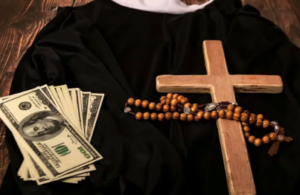
Over the last week, there have been two cases of alleged clergy sex crimes that grabbed our attention here at Horowitz Law, and we have seen a lot.
• Maryland monk Paschal Morlino was moved to Pennsylvania after being abruptly ousted from his church “following the recent disclosure that he paid $200,000 to quietly settle allegations of fraud and sexual assault.”
• A Pennsylvania priest with a striking assignment history was arrested and charged with producing child sexual abuse material (AKA child porn).
Why focus on these two unrelated cases in other states? It reminds us that even a cleric with a dedicated following and a long tenure can be accused of sexual misdeeds. The other case is an important reminder that we should watch out for ‘red flags’ in clerics’ behaviors and histories.
The Maryland Case
Last week, the Baltimore Archdiocese dismissed Fr. Paschal Morlino, “the celebrated ‘urban monk’ of Southwest Baltimore who led St. Benedict Church for decades,” after it was disclosed that in 2018, he secretly paid $200,000 to settle allegations of fraud and sexual assault quietly.
According to church sources, “Fr. Morlino’s abrupt removal comes amid an investigation by The Baltimore Banner that brought details of the 2018 settlement payment to the attention of archdiocese officials.” One ‘red flag’ here is the priest’s apparent access to a lot of money. Many predatory priests, nuns, brothers, bishops, and seminarians secretly squirrel cash away. Maybe they fear they’ll need it to pay for a lawyer or a sudden flight to a nation without an extradition treaty with the US. Perhaps the plan is to use it to buy expensive gifts for prospective victims or, as Fr. Morlino evidently did, to pay off a victim who threatens to talk.
Another possible ‘red flag:’ Fr. Morlino’s exalted status as ‘the celebrated urban monk of Southwest Baltimore. Some believe that child molesting clerics deliberately scheme to appear saintly to their flocks to have access to the vulnerable. Others believe that some child molesting clerics perform admirable work in the community (often with marginalized, threatened, or impoverished groups) because they’re psychologically tormented. Deep down, they know they’re committing horrible crimes, so to ‘make up for’ their wrongdoing, they become overachievers in terms of public service. Either way, when a cleric becomes known as a saintly figure, that can be a troubling ‘red flag.’
The Pennsylvania Case
Fr. Anthony J. Petracca was ordained in 1985 for the Altoona-Johnstown Diocese. For almost 40 years, Fr. Petracca bounced around from working as a short-term assistant in several parishes, a hospital chaplain, a campus minister, and an unspecified position in a retirement home for clerics. To put it succinctly, Fr. Petracca was moved a lot, had several chaplaincy positions, and had an unusual number of apparent gaps in his work history. These anomalies should have set off alarm bells among Altoona church officials, colleagues, and perhaps even his flock.
The moves: He worked at a total of six central Pennsylvania parishes: in Altoona (Our Lady of Lourdes and Immaculate Conception), Johnstown (St. Patrick’s and St. Andrew’s), Bellefonte (St. John the Evangelist), State College (Our Lady of Victory) and three in Windber: St. Anthony of Padua, SS. Cyril & Methodius and St. Elizabeth Ann Seton. Inexplicably, in 2004-2005, amid a supposed decade-long leave, Fr. Petracca was listed as ‘in residence’ at a Salt Lake City, Utah parish.
Why is this noteworthy? Because frequent transfers are common with problematic priests. This is especially true when, for no apparent reason, diocesan priests (who have sworn to obey one local bishop and remain under his supervision in his diocese for their entire careers) suddenly get moved to another diocese, especially in a state that’s far away. Historically, this has been a way to make it harder for law enforcement to pursue offenders. The chaplaincies: Fr. Petracca was also assigned to Juniata College in Hollidaysburg, Dmitri Manor Hollidaysburg (a home for elderly priests), and three hospitals in Johnston (Good Samaritan Medical Center, Memorial Medical Center-Lee Campus). It’s unclear, but he was likely a chaplain in these facilities. This residence was for aged diocese priests with 12 beds, 4-7 residents, and one staff member. Petracca is not listed as a chaplain.
Why is this noteworthy? Because again, if you look at the most notorious child molesting clerics in history, almost all spent some time as chaplains. Why? Because most of the most egregious serial child molesting clerics have similarly been moved from parish work into institutional work. Such transfers give bishops some cover because they can tell families who have reported or suspected abuse, “I’ve moved Fr. Paul to an assignment where it will be harder for him to be around kids” or “In his new position, Fr. Alan will be around college students, not elementary kids” or “I’m sending Fr. Bill to an institution in which he’ll be much more closely supervised and won’t have access to youngsters alone.”
The gaps: According to the Official Catholic Directory, Fr. Petracca’s assignments were interspersed with years in which he evidently did not work at all. For an entire decade, from 2000-2010, he was listed in the directory as ‘absent on leave.’ Three times, he was not indexed in the Directory (from 1988-1989, from 2010-2012 and 2014-2015).
Why is this noteworthy? Because most of the most egregious serial child molesting clerics have similarly checkered work histories. Another reason is that Catholic officials found – and still find – moving predator priests to new, unsuspecting parishes an easy and tempting way to mollify concerned church-goers and upset parents. (“Look, I can’t defrock Fr. Mike. Only the Vatican can do that. But I’ve made sure he’ll never be in your parish again.”)
Finally, listing a priest as ‘on leave,’ enables his church supervisors to say or imply that they’re taking allegations of wrongdoing seriously, say or imply that a cleric’s problems are not pedophilia, and reassure the flock that “Fr. Stan is getting the professional help he needs to deal with his depression/alcoholism/etc.”
The good news, however, is that:
- In July 2017, Fr. Petracca was put on leave due to a child sex abuse allegation,
- In 2020, he was included on the Altoona-Johnstown diocese’s ‘credibly accused’ list and was arrested earlier this month.
Let’s hope he will be successfully prosecuted, convicted, and kept away from children. And let’s hope all of us will be vigilant and attuned to ‘red flags’ in clergy behaviors or patterns. They may mean little or nothing. Or they may be a warning sign of troubling behavior. If you saw, suspected, or suffered any wrongdoing by Fr. Morlino, Fr. Petracca, or any church employee or official, we at Horowitz Law hope you’ll contact independent sources of help, like law enforcement and/or civil attorneys.
Horowitz Law is a law firm representing victims and survivors of sexual abuse by religious authority figures and other clergy. If you need a lawyer because a member of a religious organization sexually abused you, contact us today at 888-283-9922 or [email protected] to discuss your options today. Our lawyers have decades of experience representing survivors of clergy sexual abuse nationwide. We can help.
